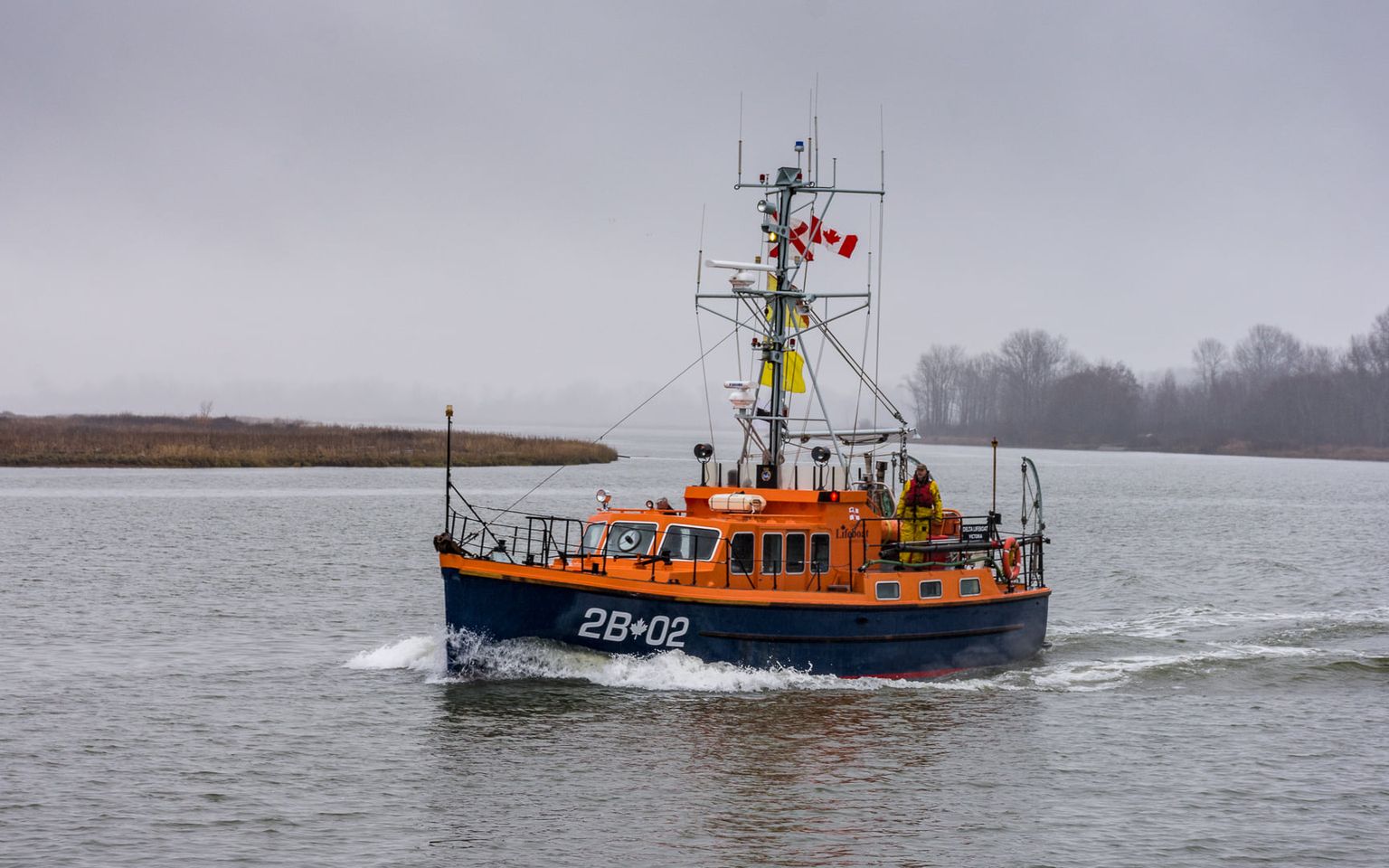The 2021 herring fishery in the Gulf of Georgia was again attended by the ‘Delta Lifeboat’ that deployed for 15 days.
With COVID restrictions and protocols in place and a crew limited to 5 Delta L/B sailed for the grounds on Sunday 28 Feb 2021 with winds from the SE ranging from 20 – 35 knots. An interesting transit was made to Baynes Sound where a protected anchorage was found in company with several seine boats in Henry Bay.
It was now a question of waiting for the fish. This would prove to be a somewhat different year. High winds, COVID-19, the fish arriving late and spread out from north of Cape Lazo, south to Nanaimo. Combined this made it difficult to decide where the most pressing need might be. Delta Lifeboat’s patrol area was mainly decided in consultation with Mike Frost of Canfisco and by monitoring the AIS movement of Packers.
While waiting the week prior to the start of fishing the time was well-spent conducting checks and maintenance on all equipment and training. Some minor electrical repairs were traced and repaired thanks to the technical skills o four engineers. Bruce D. inspected all the medical supplies and equipment on board and stowed it into a new ‘jump’ bag. Once completed, training was given to all crew members. Other training during the week consisted of towing, anchoring, boat work, MOB, and transfer of patients from RHIB down to the after mess, using the boom and purchase. This last in case we had to transfer a heavy patient.
At the conclusion of training, which added up to 28 hours, some crew task sign-offs were done. Some of the training was spent in trying to improve actual methods used in evolutions to save time and improve safety. The crew fully engaged in this and good ideas brought forward. During one of the towing exercises, the WorkSafe B.C. launch joined and allowed Delta L/B to take it in tow. Again demonstrating the close bond CLI has with FishSafe and WorkSafe B.C.
Owing to COVID restrictions ‘Delta L/B’ spent no time in the harbor except for water or crew change. The only exception to this was the last day in French Creek when after a crew change it was decided to wait overnight for an improvement in the weather.
As far as the actual fishery went, the action was mainly over 5 days starting with the seines who fished from French Creek down to North West Bay. The weather was fine as Delta L/B patrolled through the fleet. The gillnetters opened the following day off Cape Lazo so Delta L/B proceeded north at her best speed. After a patrol through the fleet to get a feel of where the main action would be, Delta L/B came to anchor where a continuous radio and visual watch could be maintained. 24 hours later it appeared that the fleet was thinning out and moving south and Delta L/B weighed anchor and also moved south through Lambert channel and around Hornby Island where some fishing was observed. A phone call with Canfisco indicated however that the main event was still at Cape Lazo, so Delta L/B returned to anchor on the south side of the Cape.
At midnight the weather changed from a light breeze to SE 15 – 20 knots. This made the anchorage very uncomfortable and little sleep for those off watch. However, because the gillnetters were continuing to fish off the lee shore and a real risk of a vessel being swamped, Delta L/B stayed on station. During the morning watch the seine boat ‘Sun Fisher’ was observed dragging anchor onto the lee shore. After dragging for 2 – 3 cables Delta L/B was able to alert the crew who weighed anchor in time and move into deeper water. By midday, Delta L/B was advised that the fishery was moving down to the Qualicum River and so redeployed to that location. Night watches were again maintained as the fishing was quite intense. Delta L/B stayed in the area until the conclusion of fishing when she proceeded into French Creek for a crew change.
At midday, a gillnetter was towed in by another one and secured on Delta L/B’s dock. It turned out they had run over a net and fouled both inboard/outboard props. Later in the afternoon a diver arrived on the scene and proceeded with a clearance dive. The crew from Delta L/B assisted. The props and bearings were removed and finally cleared. Thanks were received from the fisherman and the diver. Although it had been planned to leave for Nanaimo that afternoon it was decided to wait out the weather overnight (it was blowing SE 25). On Sunday morning it was still blowing SE 15 – 20 but forecast to go to the NW. The decision was made that after securing the lifeboat for possible heavy weather that at midday Delta L/B would slip and transit directly for the Fraser River. After clearing harbor the wind had dropped to 15 knots. However, the old sea made for a very wet ride until abeam of Nanaimo when the promised wind of NW 30-35 knots was encountered. With a quickly rising sea from astern, the watch went onto manual steering which gave them more practice of heavy weather steering. All hands performed well.
Sand Heads was reached at 17:30 and with a 6-foot sea running a very careful approach had to be made staying very close to the lighthouse before turning, with white water everywhere it was a relief to gain the protection of the breakwater. Few realize that it is conditions exactly like this that have claimed so many lives over the years. In fact, Sand Heads was the #1 most dangerous piece of water in Canada for many years.
Delta L/B secured at her Ladner station at 18:30. A huge ‘BZ’ to all the crew who participated.
